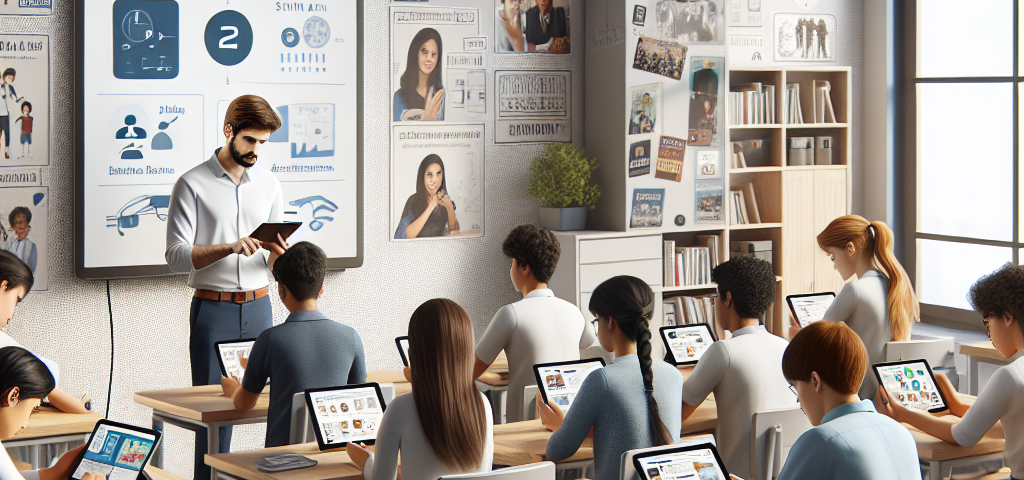
Building Bilingual Brains: Effective Strategies for Primary French Lessons
May 31, 2025
Cultural Enrichment: How French Secondary Schools Foster Global Citizenship
May 31, 2025
In recent years, technology has become an integral part of the educational landscape across the globe, and France is no exception. The digital revolution has significantly transformed the framework of secondary education, reshaping how knowledge is imparted and absorbed in French secondary schools. This article delves into the multifaceted role of technology in modern French secondary education, examining its implementation, benefits, and the challenges faced.
The Integration of Technology
Digital Classrooms
The advent of digital classrooms has redefined the traditional learning environment. In many French secondary schools, interactive whiteboards, tablets, and computers are routinely employed to facilitate learning. Students have access to a plethora of online resources, enabling them to engage with material in more dynamic ways. Google Classroom and other Learning Management Systems (LMS) allow educators to assign tasks, provide feedback, and monitor progress, fostering a collaborative atmosphere.
E-Learning Platforms
E-learning platforms such as France’s CNED (Centre National d’Enseignement à Distance) have gained traction, especially during the COVID-19 pandemic. These platforms offer courses that cater to various educational needs—whether it’s for students seeking additional support or those desiring a more flexible schedule. They provide an alternative means of delivery that is accessible and often self-paced, which can be advantageous for diverse learning styles.
Benefits of Technology in Education
Enhanced Engagement
One of the most notable benefits of incorporating technology into education is the heightened level of engagement among students. Interactive tools such as gamification and augmented reality can make learning more enjoyable and relatable. For instance, subjects like history and science can be brought to life through virtual simulations that allow students to visualize concepts beyond traditional textbook learning.
Greater Accessibility
Technology democratizes education, making it more accessible to all students, regardless of their socio-economic backgrounds. Online resources enable those in underfunded schools to access high-quality materials that may otherwise be unavailable. Moreover, technology can assist students with disabilities by offering tailored resources that accommodate their specific learning needs.
Fostering Critical Skills
In a digital age dominated by information, it’s crucial for students to develop critical thinking skills. Technology encourages students to research, analyze, and synthesize information. They learn not only to consume content but also to discern quality information from unreliable sources, a skill that is increasingly relevant in today’s media landscape.
Challenges of Integration
Digital Divide
Despite the myriad benefits of technological integration, challenges persist, notably the digital divide. Geographic disparities and economic inequalities in access to technology can exacerbate educational inequities. Schools in urban areas may be better equipped than those in rural regions, leading to significant gaps in educational opportunities.
Teacher Training
Another considerable challenge is the need for continuous training for educators. Teachers must be proficient in using technological tools to maximize their potential in the classroom. Without proper training, the effectiveness of technology may be hindered, resulting in frustration and disengagement among both educators and students.
Over-Reliance on Technology
While technology can enhance learning, there is a risk that over-reliance on digital tools can diminish critical interpersonal skills. Collaborative projects, discussions, and face-to-face interactions remain pivotal for holistic education. Ensuring that technology enhances rather than replaces traditional pedagogical methods is essential.
Conclusion
The role of technology in modern French secondary education is both transformative and multifaceted. It provides exciting opportunities for enhanced engagement, accessibility, and the development of critical skills among students. However, addressing challenges such as the digital divide, the need for teacher training, and maintaining a balanced educational approach is essential.
As France continues to navigate this technological landscape, it stands at a pivotal moment; the successful integration of technology in education has the potential to shape the future of its students and, by extension, society as a whole. Embracing these changes while remaining mindful of their implications will be crucial in crafting an educational environment that is inclusive, equitable, and forward-looking.

